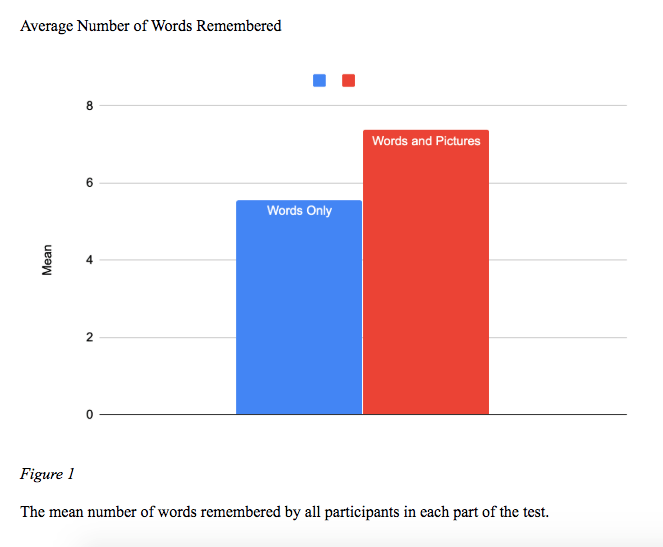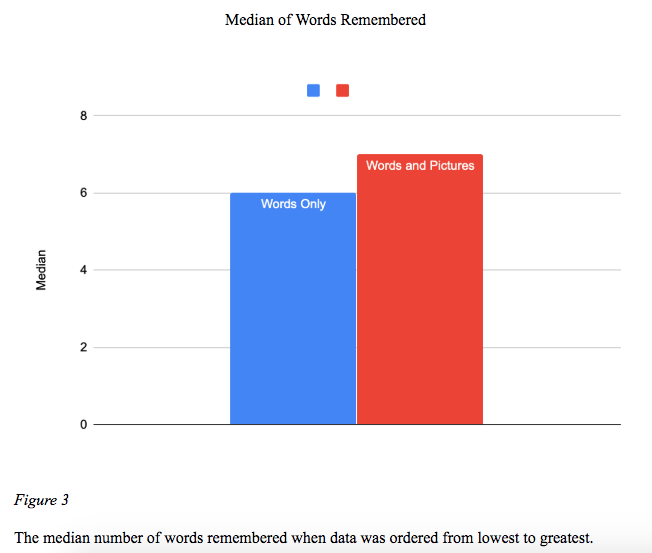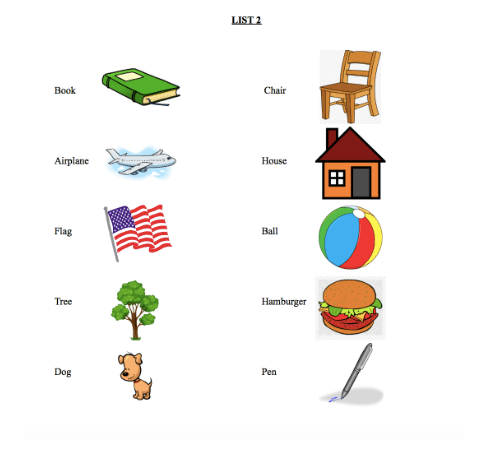By William Osborne and Julian Yang, VI Form
The Effect of Visual Support on Learning: A Psychology Case Study
Abstract
Memorization plays a major role in education, especially throughout grade school and middle school. Despite this, many teachers support studying for memorization based tests by only repeating the information needed until it is stuck in the student’s brain. This study examines the positive effect visuals have on the brain’s ability to memorize words. Past experiments have found that the inclusion of images with text would increase a person’s ability to memorize and recall information. To test this, participants were given a short period of time to memorize ten words and then recall them. The same process was then repeated, but with a different list which also contained images of the words. The results showed that participants’ ability to memorize was facilitated with the use of images. One possible explanation is that the brain is able to mentally picture the image when remembering the words, giving it a concrete example to pull from instead of only a few letters on a page.
Keywords: Memorization, Visual Learning, Information Recall, Learning Strategy
Visual Learning and Memorization
Throughout history, humans have communicated with pictures. Before language was recorded with words, cave painters expressed themselves through visual representation. Children are exposed to pictures and drawings before learning to write, listen, read, and speak. Despite this, traditional education systems have resolved to verbal and written instructions. As students get older, there are fewer pictures associated with subjects, and the ratio of words to pictures rises. Teachers rely on written material and lectures to convey information to students. Tests and assessments are based more on memorization, such as vocabulary tests, rather than analysis and application. Recent studies, however, have found learning with visual aids, including diagrams, charts, and photographs, aid a person’s ability to learn and recall information (Bobek & Tversky, 2016).
Visualization is effective because of the brain’s method of storing visual information. Images are processed in as little as 13 milliseconds (Trafton, 2014), nearly 60,000 times faster than words (Vogel, Dickson, & Lehman, 1986). This is due to the fact that the brain is constantly processing visual information, making decisions based on observed surroundings. Allan Paivio’s dual-coding theory states that human cognition allows for the processing of both language and nonverbal objects, such as images. By only using words, humans are activating only one part of their full cognitive ability.
The current experiment attempts to further explore the effectiveness of visual learning. In recent years, students at St. Mark’s have been consistently encouraged to use the Big Six Learning strategies. Instead of memorizing a list of words and facts, students are encouraged to use newer, innovative methods for mastery. While dual-coding is not strictly limited to the pairing of images with words, visuals are usually the commonly used method. Students use this method by pairing related, non-verbal information with text. However, this has never been tested in a controlled manner. It was hypothesized that, based on the prior research on this topic, participants would perform better recalling words on a memorization task when they were given visual aids, as compared to having strictly words. The images associated with the words would allow the participant to retrieve a concrete example, standing out more through their unique color and shape. Individual words would blend in with the rest of the list and could possibly slow down the speed at which the participant processed the words.
Methods
Participants
Participants consisted of 16 St. Mark’s students from the 3rd form to the 6th form. Two boys and two girls were selected at random from each grade and at different locations of the school. Participant consent was obtained by means of signed informed consent forms which detailed the purpose of the study, risks and benefits, and asked for voluntary participation.
Variables
The independent variable is the presence of a visual aid. The dependent variable is the number of words a participant could recite from memory. The constant variables included font size, color of text, and spacing of words.
Procedure
The materials were two lists of words that referenced objects, such as “cup”, “lightning”, and “block”. These words, while different, could all be represented with tangible images. The first list (Figure 5) contained ten words, with one on each line. The second list (Figure 6) contained ten different words with a correlating clipart picture directly beside it. The selected words are colloquial, preventing any confusion by the participants. The participant was not shown the list of words prior to testing. A three second countdown was given using “go” as the starting command. The participant flipped over the sheet, and was given twenty seconds to memorize the words. Once time was up, the sheet was removed, and the participant recited back as many words as they could recall in ten seconds, in any order. The same process was then followed with the second list, which contained images paired with the words. The participant was not shown the list until instructed to do so. After twenty seconds, the participant recited the words on the list, regardless of order. After each test the number of words recalled was recorded.
Results
The dependent measure is the number of words remembered from each test list. As seen in Figure 1, participants recalled more words with pictures (Mean = 7.4) as compared to without pictures (Mean = 5.6) . The data yields no evidence that suggests gender or grade level may improve or worsen participants’ ability to memorize words. No trials resulted in images worsening the participant’s ability to memorize the words.
Discussion
This experiment examined the effect of a visual aid with learning. The stated hypothesis was that the inclusion of visual aids would increase the number of words recalled by the participant. The data supports this claim. Although there were three cases where the participant had the same number of words recalled with and without the presence of a visual aid, there was never a decrease in the number of words remembered. This increase does not suggest that visual learning has a landslide margin over the words-only test. The maximum increase was three words, with the average increase being 1.8. Even with the inclusion of a visual image, only one participant accurately recalled all ten words on the list. More testing will be required in order to better examine the performance of the school as a whole.
The observed trends bear similarities to the results of previous studies. Research supports the claim that providing illustrative examples enhanced conceptual learning in comparison to learning strictly concept definitions (Rawson, Thomas, & Jacoby, 2014). This use of dual-coding allows the brain to function with additional potential. In addition to memorization, visual learning leads to more information retention than alternative learning methods, such as verbal learning (Lu and Yang, 2018).
To achieve a more accurate and widespread conclusion, this study would have to be tested through additional participants. Although form and gender distribution was carefully considered, this experiment does not provide enough information to make an accurate claim about the effectiveness of visual learning at St. Mark’s. For example, two participants chosen at random could be practitioners of visual learning, therefore giving them an advantage over those who have never used this strategy. Background screening of randomly selected participants would allow us to filter out more of these variables. Additionally, the environment and time were not controlled. Tests were scattered through the morning, afternoon, and night. Location was also random. The lack of control over environment could have an impact on a participant’s ability to learn and recall the word lists, as some tests were conducted in quiet locations (the library), and others in more populated ones (Burnett). However, the impromptu nature would not have allowed the ability to have complete control over participants and location. The participants could only be asked for testing based on the amount of previous participants, sorted by form and gender.
Future testing would allow us to reach more participants based on learning style. This would grant us an evenly-distributed number based on whether or not a participant has used visual learning strategies. When performing the first test, participants could be employing the strategy of visual learning, even though the list only contained words. There is no method to see what strategy a participant used to help them with memorization. This proposed background survey would clarify our data, allowing us to see results and make more accurate conclusions.
More thought given into time constraints could also give us better data. Some participants may read and memorize words slower than others, resulting in inconsistencies with test data. Screening would show us a clearer picture of St. Mark’s students and visual learning. However, this could only add more variables to the equation, making it more difficult for conclusions.
Although this study compared the performance between the presence of a visual representation, it did not test the limits of memory. A possible explanation of an average maximum word recall at around 7 is George Miller’s theory of short term memory capacity. Further testing would be needed to examine the capacity of short term memory. Even though there was an average max, there was still a general increase.
This study supports the idea of visual learning. Many students often ignore or are not willing to take the extra step when reading and processing information, thinking that there is no tangible benefit to creating visual images. Although this test used basic objects, the strategy can still be employed to various subjects, regardless of how complex they may seem. Even if participants mentally pictured illustrations when performing the first test, the inclusion of concrete images shows an upward trend of memorization. As discussed previously, the human brain is better equipped to process images, and students should take greater advantage of this ability to increase memorization and learning performance.

Will Osborne is a VI form boarding student from New York City. His favorite subjects are English and Science, and he enjoys spending time with friends.

Julian Yang is a VI Form boarding student from Chelmsford, Massachusetts. He enjoys studying social sciences, law, and mathematics. His extracurricular interests include the saxophone, hockey, and filmmaking.
References
- Bobek, E., and Tversky, B. (2016). Creating Visual Explanations Improves Learning. Cognitive research: principles and implications, 1-27
- Trafton, A. (2014, January 16). In the Blink of an Eye. Retrieved from http://news.mit.edu/2014/in-the-blink-of-an-eye-0116
- Vogel, R. D., Dickson, W. G., and Lehman, A. J. (1986). Persuasion and the Role of Visual Presentation Support: The UM/3M Study. Minneapolis, MN.
- Rawson, A. K., Thomas, C. R., and Jacoby, L. L. (2014). The Power of Examples: Illustrative Examples Enhance Conceptual Learning of Declarative Concepts. Educational Psychology Review, 483-504.
- Lu, T. and Yang, X. (2018). Effects of the Visual/Verbal Learning Style on Concentration and Achievement in Mobile Learning. EURASIA Journal of Mathematics, Science, and Technology Education, 1719-1729.








